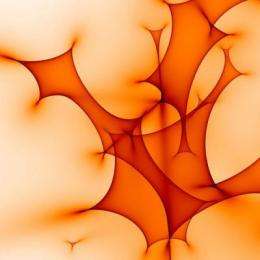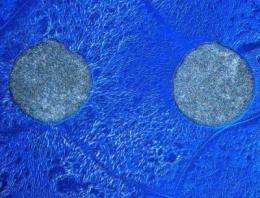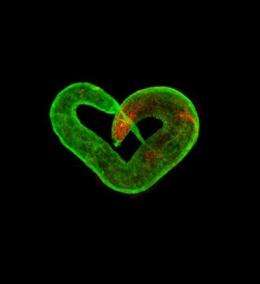Exhibition showcases the 'art of science'

The online gallery for Princeton University's third Art of Science competition will go live Thursday, May 14, at noon EDT. An online site that allows members of the public to choose their favorite 2009 Art of Science image will go live at the same time.
The juried show features 48 works chosen from more than 200 submissions, and the online gallery can be found here: www.princeton.edu/artofscience/2009
The theme of this year's competition was "found art," with the organizers of the exhibit soliciting scientific images created during the course of an actual research project, rather than art inspired by science.
"This show exuberantly supports the idea that images produced in the pursuit of science can have an aesthetic value that is on a par with art created for art's sake," said Andrew Zwicker, the head of Science Education at the Princeton Plasma Physics Laboratory (PPPL) and a lecturer in the Princeton Writing Program.

"We hope that this exhibit will serve as a window through which the wider, non-technical audience can appreciate and understand the importance of scientific research," said Adam Finkelstein, associate professor of computer science and one of the exhibit organizers.
The top three prize winners for 2009 Art of Science competition were announced at a gallery opening on the Princeton University campus on May 8.
First prize went to Celeste Nelson, assistant professor chemical engineering, for baby squid, an image of squid embryos taken using bright field microscopy. Second prize went to Pat Watson, Mike Gaevski, Joe Palmer, and Conrad Sylvestre of Princeton's Micro/Nanofabrication Laboratory (MNFL) for their entry Desert Butte, a scanning electron microscope image. Third Prize went to Maria Ciocca, a 2005 alumna now at the University of Pennsylvania School of Medicine, for Worm Love, an image taken using immunofluorescence microscopy.
The jurors for the top prizes were Shirley M. Tilghman, president of Princeton University and a renowned molecular biologist; the internationally acclaimed photographer Emmet Gowin, who is a professor in the Program in Visual Arts at Princeton; David Dobkin, dean of faculty and a professor of computer science at Princeton whose research focuses on computer graphics, and the Pulitzer Prize-winning poet Paul Muldoon, chair of Princeton's Lewis Center for the Arts.
"It was an invigorating and inspirational experience for me, I must say, to be reminded of the extent to which the structures and patterns of the natural world anticipate the structures and patterns we describe as art," said Muldoon after finishing the judging last week. "It was particularly striking, too, given the alacrity with which we agreed on the top pieces, to be reminded moreover of how art chooses us rather than our choosing it."
Emmet Gowin, who has served as a judge for all three Art of Science competitions, said that it "is always a joy to see and study the amazing images that 'Art of Science' brings together."

"Nature is obliviously full of amazing forms and surprises and so is the human imagination," Gowin said. "It seems to me that the collaboration between photography, in its many forms, and the natural sciences has been of one of the most fruitful meeting places of our modern world. The 'Art of Science' is one of those lovely projects with which we should never be finished."
Cash prizes were given to the top three entrants in amounts calculated by the golden ratio (whose proportions have since antiquity been considered to be aesthetically pleasing):
1st Prize -- $250.00
2nd Prize -- $154.51
3rd Prize -- $95.49
The Art of Science "People's Choice" award of $196.53 (the geometric mean of the first and second prizes) will be awarded to the artist of the piece that receives the most online votes as of July 1, 2009 at noon EDT.
Viewers can vote for their favorite Art of Science images at:
www.princeton.edu/artofscience/2009/vote
The Art of Science voting gallery was created by a team headed by Matthew Salganik, an assistant professor of sociology at Princeton. The site builds upon an existing project called Photocracy, which draws on ongoing research at the Center for Information Technology Policy combining sociology, systems
engineering, and theoretical computer science.
"The platform we have built is essentially a suggestion box for the digital age, a tool that will enable groups to collect and then collaboratively evaluate new information such as ideas or photos - or in this case, the art of science," said Salganik.
David Dobkin, one of the official judges for the competition, noted that, "as in past years, the quality of submissions to the Art of Science exhibit this year made judging almost impossible."
"The committee felt that many of the entries were worthy of recognition and it was difficult to narrow our selections down to three favorites," said Dobkin. "It will be interesting indeed to see whether the viewing public echoes our choices or offers a different opinion altogether."
Source: Princeton University (news : web)
















